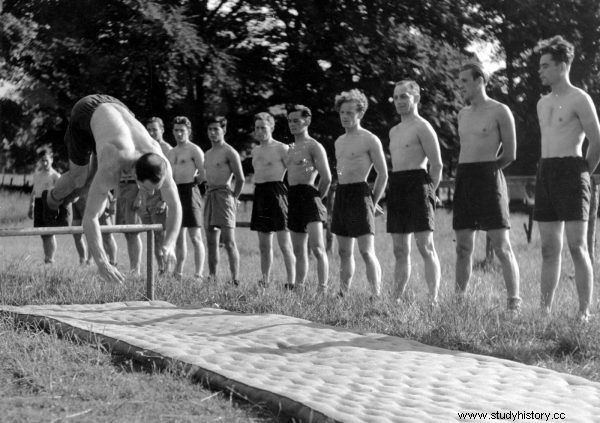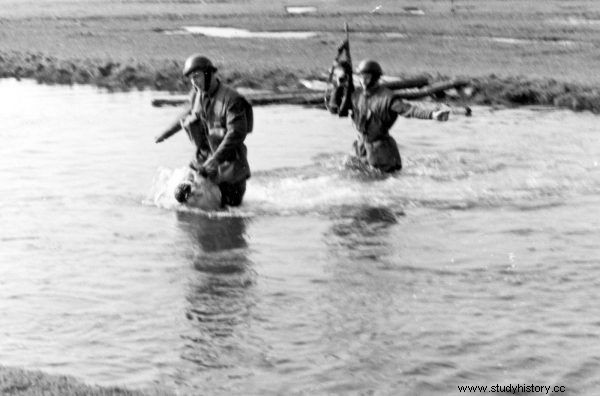They were the elite of the Polish army during World War II. Their skills were the result of relentless training. Few have survived it. The toughest who managed to do so became real machines for killing Germans.
When the formation of the Independent Parachute Brigade began, it included both young 18-year-olds and serious 50-year-olds. As you can easily guess, their physical fitness was at a completely different level. No wonder then that the training staff of the brigade put so much emphasis on increasing the physical strength of candidates for paratroopers. It is for this purpose that a special obstacle course called "monkey grove" was created (we already wrote about it a few years ago, presenting the topic of training the Cichociemni) .
Outdoor Torture Chamber
It was built on the Scottish estate of Largo House, located in the area where the unit is stationed. The very idea of its creation was born in the minds of the officers of the Polish formation, they also largely financed this real open-air torture room from their own resources.
The inscription above the gate:"You are looking for death, come in for a moment" testified to the challenge that awaited the newcomers. . So how did the "monkey grove" look like? We can find out about this by reading the testimony of the standard-bearer Władysław Gołębiowski:
When everything that a man needed for his inevitable disability had been prepared, the first group of doomed was released . […] They started with a jump from a tree blown over by a storm from a height of 50 - 80 cm. And since the tree was round and not all the fifty-year-old Icaras could maintain their balance, a flat slat was nailed to the standing form, and for safety the ground was softened for a jump.

During the training, no one could count on a reduced fare.
After the jump, the brave marched on the so-called trapeze. It was a swing suspended from a branch of a sprawling, ancient oak, a device of inevitable bruising of the "soft part of the body". Those who were terrified of swinging - it sometimes cost some of their ankles to break. Then - walking on poles […]. What an equilibrium movement the adept had to make, sometimes grabbing the air with both hands to stop him for a moment, let alone walk its entire length.
Now, ladies and gentlemen, the roach! Three meters tall. "One, two and on the other side," the instructors commanded. It was beautiful, but for an adept old man it is a wailing wall. […] To further torment the adept, a wall with a window was built of wood, through which they had to dive, quickly, one by one. And then to the crossbar, over the river, and here we needed trained hands, because half of the crossbar - sliding on the tummy, and for the other half, hanging on the arms and legs - walking towards the goal. Untrained hands gave a certain guarantee - a bath in the river.
Hop to the "hole"
Of course, future paratroopers did not live by the "monkey grove" alone. They had to run a minimum of 10 kilometers every day , in addition, they trained, among others hand-to-hand combat and crawling under the entanglements. For those who survived this murderous test, the next stage of training was waiting - the so-called "hole". This term was a cut in the ceiling of the former stable, imitating the hole in the floor of the Whitley bombers used by the British to transport airborne troops.

You can read about the participation of Polish paratroopers in Operation Market Garden in the book by Antony Beevor entitled "Arnhem" (Horizon 2018 sign).
As Krzysztof Jan Drozdowski points out in the book Sosabowcy training "in the hole" was decisive. It was there that "the knowledge and skills needed to perform a parachute jump were instilled in soldiers" . Also during this phase of training, there were many bruises and fractures, but "there was no shortage of laughter as well" .
Once the basics had been mastered, the next must-see point was the 25-meter parachute tower. It gave a foretaste of what awaited the soldiers during the real parachute jump. It allowed you to get used to "throwing yourself into the abyss, to tame your self-preservation instinct which prevents a man from making such moves ”.
This was the end of the first training round. Those who successfully passed it went to the British Parachute School No. 1 in Ringway. The "monkey grove" was waiting for the less fit. During the one-week and two-week course in Ringway, our soldiers made eight jumps:two for a day from a balloon, five for a day from a plane, and one for a night from a balloon.

The training of General Sosabowski's soldiers also included, of course, the appropriate number of parachute jumps.
In 1943, the training methods were slightly changed due to the introduction of new bombers into service, which no longer jumped through a hole in the floor, but through a side door. After successfully completing the statutory number of jumps, Polish paratroopers returned to their home unit, where they began the last - and at the same time the longest - stage of their training.
"Root" course
Its guidelines were set by Stanisław Sosabowski himself, whom - as Antony Beevor emphasizes in the book Arnhem - “subordinates were respected. They feared him, but also trusted him, because he was able to do whatever he asked of them. " The commanders of battalions and special companies were responsible for drawing up detailed programs. As we can read in Krzysztof Jan Drozdwoski's book:
In the training program, the greatest emphasis was put on developing and maintaining the best possible physical condition, on developing the spiritual values necessary to act in isolation, on mastering the equipment that was equipped with the parachute brigade and in the possession of the enemy. A lot of emphasis was placed on harmony and compatibility.

During the training, particular emphasis was placed on physical fitness and cooperation of the soldiers.
Considerable attention was also paid to making the soldiers of the brigade independent in the field, which was to become their ally, not their enemy . To achieve this, the brigade commander prepared a special rootstock course, read:"gifts of nature such as berries, mushrooms, birds, etc., which under special conditions were to enable them to survive."
Dunkeld on the River Tay, located several dozen kilometers from Edinburgh, was chosen as the site of the exercises. There were actually ideal conditions for this type of training. In addition to rock climbing, water and - rare in Scotland - forest, the area gave a very homely impression, reminiscent of, for example, the Dunajec gorge in the Pieniny.
It was in such circumstances of nature that soldiers spent weeks practicing techniques:
move in unfamiliar territory without the help of local civilians; crossing the cross country, bypassing roads and settlements, both during the day and at night; crossing inhabited places without drawing attention to themselves; life from the field without theft and robbery, when you cannot buy; sleep safely in the most comfortable conditions possible; crossing deep rivers without swimming and ford finding skills; raft building; using a boat going downstream and upstream .

Thanks to the varied training, the soldiers of the Independent Parachute Brigade had to cope with all conditions.
Wasted potential
The training of the brigade soldiers lasted virtually non-stop due to the constantly arriving additions. Most of the newcomers had no idea what awaited them, but they soon found out in the "monkey grove". As a result, as many as 5470 people passed through the parachute courses.
They all hoped that they would take part in the liberation of Poland, instead their blood was shed in the far too ambitious and tragically planned operation "Market Garden". During it, however, Polish paratroopers showed that their murderous training was not wasted and they were ready to fighting even in the most unfavorable combat conditions, as confirmed in the book "Arnhem" by Antony Beevor.
